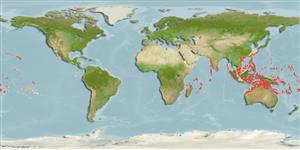>
Holocentriformes (Squirrelfishes, soldierfishes) >
Holocentridae (Squirrelfishes, soldierfishes) > Holocentrinae
Etymology: Sargocentron: Greek, sargos = sargus + Greek, kentron = sting (Ref. 45335).
More on author: Bleeker.
Environment: milieu / climate zone / depth range / distribution range
экология
морской ассоциированный с рифами; пределы глубины 5 - 90 m (Ref. 27370). Tropical; 30°N - 24°S
Indo-Pacific: Red Sea (Ref. 12541), Zanzibar (Tanzania), Aldabra and Seychelles to the Marshall Islands and American Samoa, north to Taiwan, southern Japan and the Ogasawara Islands, south to the southern Great Barrier Reef and the Chesterfield Islands. Replaced by Sargocentron marisrubri in the Red Sea (Ref. 37816).
Size / Вес / Возраст
Maturity: Lm ? range ? - ? cm
Max length : 25.0 cm TL самец/пол неопределен; (Ref. 90102)
колючие лучи спинного плавника (общее число): 11; членистые (мягкие) лучи спинного плавника (общее число): 12-14; колючие лучи анального плавника 4; членистые (мягкие) лучи анального плавника: 9 - 10. Body with red and white stripes following the scale rows; black blotch at base of soft dorsal, anal, and caudal fins, but may be faint or absent in caudal and anal fins (Ref. 4201, 48635). Uniformly small ctenii on posterior margin of scales of body. Inferior mouth due to hypertrophy of median part of upper lip (front of upper lip thickened and slightly protruding) (Ref. 3079). Five oblique scale rows on cheek; body depth 2.7-2.95 in SL; head length (HL) 2.6-2.9 in SL; snout length 3.6-4.4 in HL; interorbital width 4.4-5.25 in HL; slender caudal peduncle, depth 3.9-4.65 in HL; maxilla extending from below center of the eye to a vertical at rear edge of pupil, upper jaw length 2.25-2.4 in HL; premaxillary groove ending above or slightly posterior to a vertical at the front edge of orbit; anterior end of nasal bone ending with a small spine; surface or medial edge of nasal bone spineless; nasal fossa with 1 to 4 spinules on posterior edge; preopercular spine 3.45-3.65 in HL; longest dorsal spine 1.95-2.4 in HL; 3rd anal spine 1.5-1.75 in HL (Ref. 27370).
A relatively uncommon inhabitant of rocky reefs and coral-rich areas. Spine of preopercle venomous. Usually seen solitary , but sometimes forms schools in deep water in oceanic locations (Ref. 48635). Found in seaward slopes in 5-90 m (Ref. 90102).
Life cycle and mating behavior
половая зрелость | размножение | нерест | икра | Fecundity | личинки
Randall, J.E., 1998. Revision of the Indo-Pacific squirrelfishes (Beryciformes: Holocentridae: Holocentrinae) of the genus Sargocentron, with descriptions of four new species. Indo-Pac. Fish. (27):105 p. (Ref. 27370)
Статус Красного Списка МСОП (Ref. 130435)
Использование человеком
дополнительная информация
народные названиясинонимыобмен веществхищникиэкотоксикологияразмножениеполовая зрелостьнерестSpawning aggregationFecundityикраРазвитие икры
ссылкиаквакультура (рыбоводство)особенности рыбоводствастепень растяжениягенетикаElectrophoresesнаследуемостьболезниобработкаNutrientsMass conversion
инструменты
Специальные отчеты
Скачать в формате XML
ресурсы в Интернет
Estimates based on models
Preferred temperature (Ref.
123201): 24.8 - 28.9, mean 27.6 °C (based on 630 cells).
Phylogenetic diversity index (Ref.
82804): PD
50 = 0.5000 [Uniqueness, from 0.5 = low to 2.0 = high].
Bayesian length-weight: a=0.01622 (0.00774 - 0.03400), b=2.97 (2.80 - 3.14), in cm total length, based on LWR estimates for this Genus-body shape (Ref.
93245).
Trophic level (Ref.
69278): 4.0 ±0.66 se; based on food items.
устойчивость к внешним воздействиям (Ref.
120179): высокий, минимальное время удвоения популяции до 15 месяцев (Preliminary K or Fecundity.).
Fishing Vulnerability (Ref.
59153): Low vulnerability (15 of 100).
Nutrients (Ref.
124155): Calcium = 51.8 [20.0, 215.6] mg/100g; Iron = 0.497 [0.196, 1.509] mg/100g; Protein = 18.8 [17.6, 19.9] %; Omega3 = 0.167 [0.073, 0.378] g/100g; Selenium = 36.5 [21.0, 70.9] μg/100g; VitaminA = 78.1 [30.5, 218.1] μg/100g; Zinc = 1.62 [0.67, 3.04] mg/100g (wet weight);
